1993 BUICK LESABRE parking brake
[x] Cancel search: parking brakePage 236 of 324
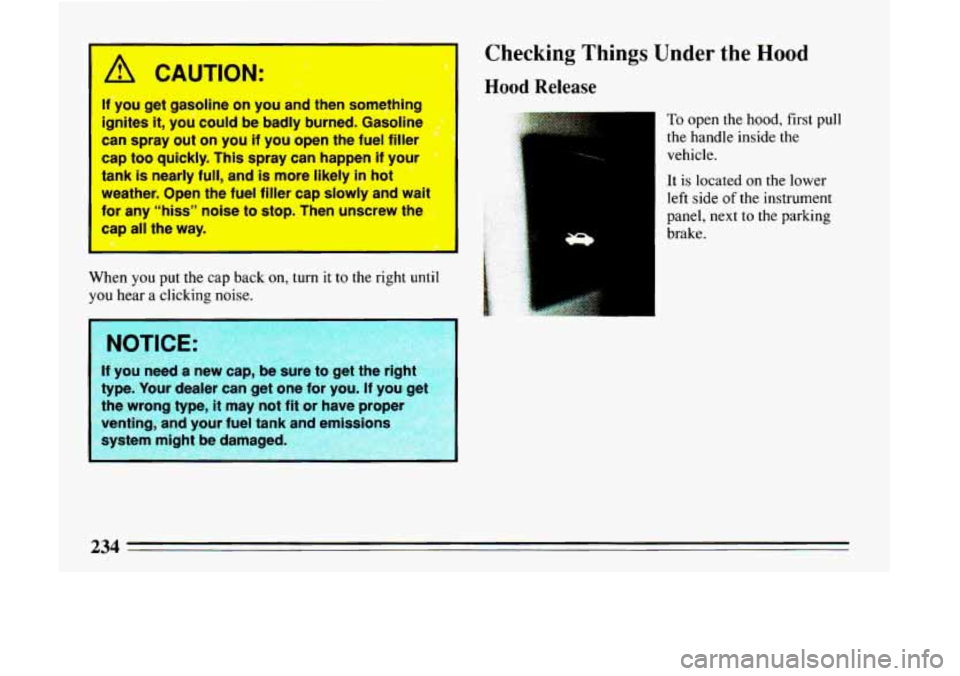
A CAUTION:
If you get gasoline on you and then something
ignites
it, you could be badly burned. Gasoline
can spray out on you
if you open the fuel filler
cap too quickly. This spray can happen if your
tank
is nearly full, and is more likely in’hot
weather. Open the fuel filler cap slowly and wait
for any “hiss” noise
to stop. Then unscrew the
cap
all the way.
When you put the cap back on, turn it to the right until
you hear a clicking noise.
1
If you need a new cap, be sure to get tlie rlgnt
type. Your dealer can get one for you.
If you ge
the wrong type, it may
not fit or have propor
venting, and your fuel tank
and emissions
system might be damaged
Checking Things Under the Hood
Hood Release
To open the hood, first pull
the handle inside the
vehicle.
It is located on the lower
left side
of the instrument
panel,
next to the parking
brake.
234
.I
Page 244 of 324

Wait at least 30 minutes before checking the transaxle
fluid level if
you have been driving:
0 When outside temperatures are above 90 " F (32 " C).
0 At high speed for quite a while.
0 In heavy traffic -- especially in hot weather.
While pulling a trailer.
To get the right reading, the fluid should be at normal
operating temperature, which is
180 F to 200 " F (82 " C
to 93 "C).
Get the vehicle warmed up by driving about 15 miles
(24 km) when outside temperatures are above 50 " F
(10' C). If it's colder than 50 " F (1 0 ' C), you may have
to drive longer.
To check the fluid level:
Park your vehicle on a level place.
Place the shift lever in 7'" (Park) with the parking
With your foot on the brake pedal, move the shift
brake
applied.
lever through each gear range, pausing for about
three seconds in each range.
Then, position the shift
lever in "P" (Park).
Let the engine run at idle for three to five minutes. Then, without
shutting off the engine, follow these
steps:
1. Pull out the dipstick and wipe it with a clean rag or
paper towel.
2. Push it back in all the way, wait three seconds and
then pull it back out again.
242
Page 272 of 324

Fuses and Circuit Breakers
The wiring circuits in your car are protected from short
circuits by a combination
of fuses, circuit breakers, and
fusible thermal links
in the wiring itself. This greatly
reduces the chance
of fires caused by electrical
problems.
You’ll find some spare
fuses in the fuse block. Be sure
to use the correct fuse.
If you ever have a problem on
the road and don’t have a spare fuse,
you can “borrow”
one
of the correct value. Just pick some feature of your
car that
you can get along without -- like the radio or
cigarette lighter
-- and use its fuse, if it is of the value
you need. Replace it as soon as you can.
The fuse panel
is located under the instrument panel,
next to the parking brake.
To release and lower the fuse
panel, squeeze the two tabs together. Then, pull it
towards you.
It will come down so the fuses can be
accessed.
c m
k
Remove the cover to access the fuses.
270
Page 288 of 324
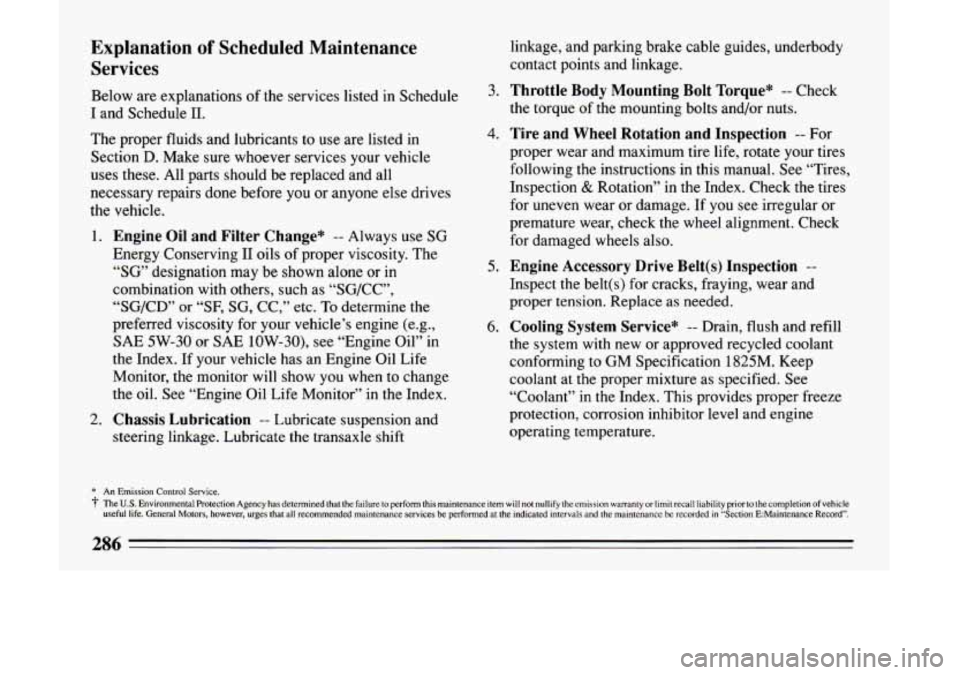
Explanation of Scheduled Maintenance
Services
Below are explanations of the services listed in Schedule
I and Schedule 11.
The proper fluids and lubricants to use are listed in
Section
D. Make sure whoever services your vehicle
uses these. All parts should be replaced and all
necessary repairs done before
you or anyone else drives
the vehicle.
1. Engine Oil and Filter Change* -- Always use SG
Energy Conserving I1 oils of proper viscosity. The
“SG” designation may be shown alone or in
combination with others, such as “SG/CC”,
“SG/CD” or “SF, SG, CC,” etc. To determine the
preferred viscosity for your vehicle’s engine (e.g.,
SAE
5W-30 or SAE 10W-30), see “Engine Oil” in
the Index. If your vehicle has an Engine Oil Life
Monitor, the monitor will show
you when to change
the oil. See “Engine Oil Life Monitor” in the Index.
2. Chassis Lubrication -- Lubricate suspension and
steering linkage. Lubricate the transaxle shift linkage, and parking brake
cable guides, underbody
contact points and linkage.
3. Throttle Body Mounting Bolt Torque* -- Check
the torque of the mounting bolts and/or nuts.
4. Tire and Wheel Rotation and Inspection -- For
proper wear and maximum tire life, rotate your tires
following
the instructions in this manual. See “Tires,
Inspection
& Rotation” in the Index. Check the tires
for uneven wear or damage. If you see irregular or
premature wear, check the wheel alignment. Check
for damaged wheels also.
5. Engine Accessory Drive Belt(s) Inspection --
Inspect the belt(s) for cracks, fraying, wear and
proper tension. Replace as needed.
6. Cooling System Service” -- Drain, flush and refill
the system with new or approved recycled coolant
conforming to GM Specification 1825M. Keep
coolant at the proper mixture as specified. See
“Coolant” in
the Index. This provides proper freeze
protection, corrosion inhibitor level
and engine
operating temperature.
* An Emission Control Service.
3‘ The U.S. Environmental Protection Agency has determined that the failure to perfonn this maintenance item will not nullify the emission warranty or limit recall liability prior to thecompletion of vehicle
useful life. General Motors, however, urges that all recommended maintenance services be performed at the indicated intervals and the maintenance be recorded in “Section E:Maintenance Record”.
286
Page 291 of 324
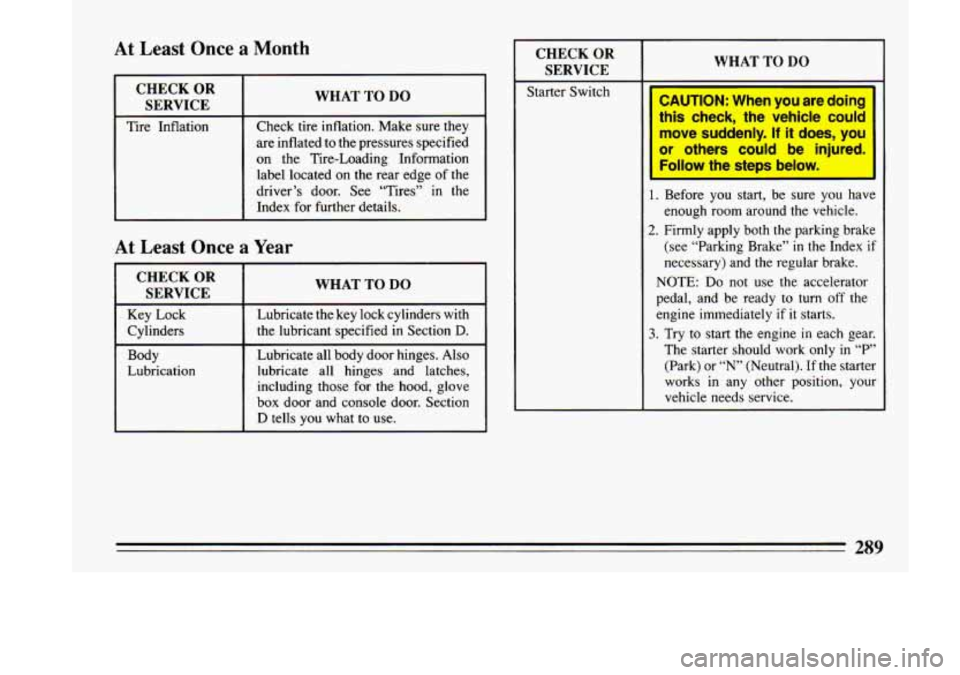
At Least Once a Month
1 CHECKOR SERVICE
I WHAT TO DO
~ ~~~
Tire Inflation Check tire inflation. Make sure
they
are inflated to the pressures specified
on the Tire-Loading Information label located on the rear edge of the
driver’s door. See “Tires”
in the
Index for further details.
At Least Once a Year
CHECK OR
SERVICE
Key Lock
Cylinders
Body
Lubrication
WHAT TO DO
Lubricate the key lock cylinders with
the lubricant specified in Section
D.
Lubricate all body door hinges. Also
lubricate all hinges and latches,
including those
for the hood, glove
box door and console door. Section
D tells you what to use.
CHECK OR
SERVICE
Starter Switch
L
WHAT TO DO
CAUTION: When you are doing
this check, the vehicle could move suddenly.
If it does, you
or others could be injured. Follow the steps below.
1. Before you start, be sure you have
enough room around
the vehicle.
2. Firmly apply both the parking brake
(see “Parking Brake” in
the Index if
necessary) and the regular brake.
NOTE:
Do not use the accelerator
pedal, and be ready to turn
off the
engine immediately
if it starts.
3. Try to start the engine in each gear.
The starter should work only
in “P’
(Park) or “N’ (Neutral). If the starter
works
in any other position, your
vehicle needs service.
Page 292 of 324

CHECK OR
SERVICE
Brake-
Transmission Shift Interlock
BTSI
Automatic
Transmission)
WHAT TO DO
CAUTION: When you are doing
this check, the vehicle could
I
move suddenly. If it does, you
or others could be injured.
Follow the steps below.
1. Before you start, be sure you have
enough
room around the vehicle. It
should be parked on a level surface.
2. Firmly apply the parking brake (see
“Parking Brake”
in the Index if
necessary).
NOTE: Be ready to apply the regular
brake immediately
if the vehicle
begins
to move.
3. With the engine off, turn the key to
the
“RUN” position, but don’t start
the engine. Without applying the
regular brake, try to move the shift
lever out of
“P’ (Park) with normal
effort. If the shift lever moves out of
“P’ (Park), your vehicle’s BTSI
needs service.
CHECK OR
I SERVICE I WHAT TO DO
Steering While parked, and with the parking
Column Lock brake set, try to
turn the key to
“LOCK” in each shift lever position.
The key should turn to “LOCK”
only
when the shift lever is in “P’
(Park).
The key should come out only in
“LOCK.”
290
Page 293 of 324
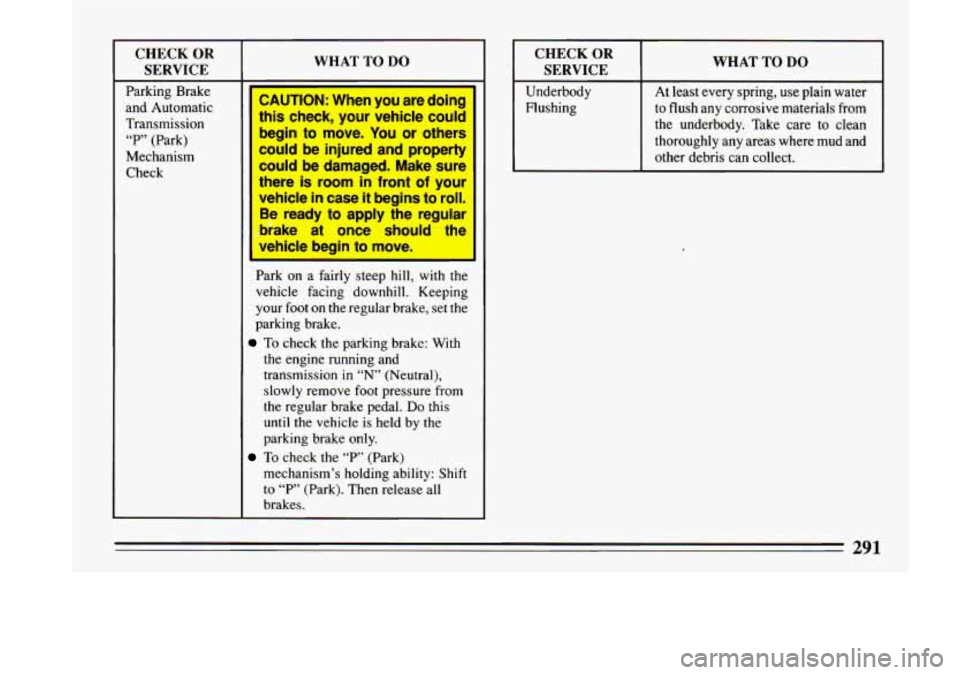
CHECK OR
SERVICE
Parking Brake
and Automatic
Transmission
“P” (Park)
Mechanism
Check
WHAT TO DO
CAUTION: When you are doing
this check, your vehicle could
begin
to move. You or others
could be injured and property
could be damaged. Make sure
there
is room in front of your
vehicle in case it begins to roll.
Be ready to apply the regular
brake at once should the
-
Park on a fairly steep hill, with the
vehicle facing downhill. Keeping
your foot on the regular brake, set the
parking brake.
To check the parking brake: With
the engine running and
transmission in
“N’ (Neutral),
slowly remove foot pressure from
the regular brake pedal. Do this
until the vehicle is held by the
parking brake only.
mechanism’s holding ability: Shift
to “P’ (Park). Then release all
brakes.
To check the “P” (Park)
CHECK OR
I SERVICE I WHAT TO DO
Underbody
Flushing At least every spring, use plain water
to flush
any corrosive materials from
the underbody. Take care to clean
thoroughly any areas where mud and
other debris can collect.
Page 295 of 324
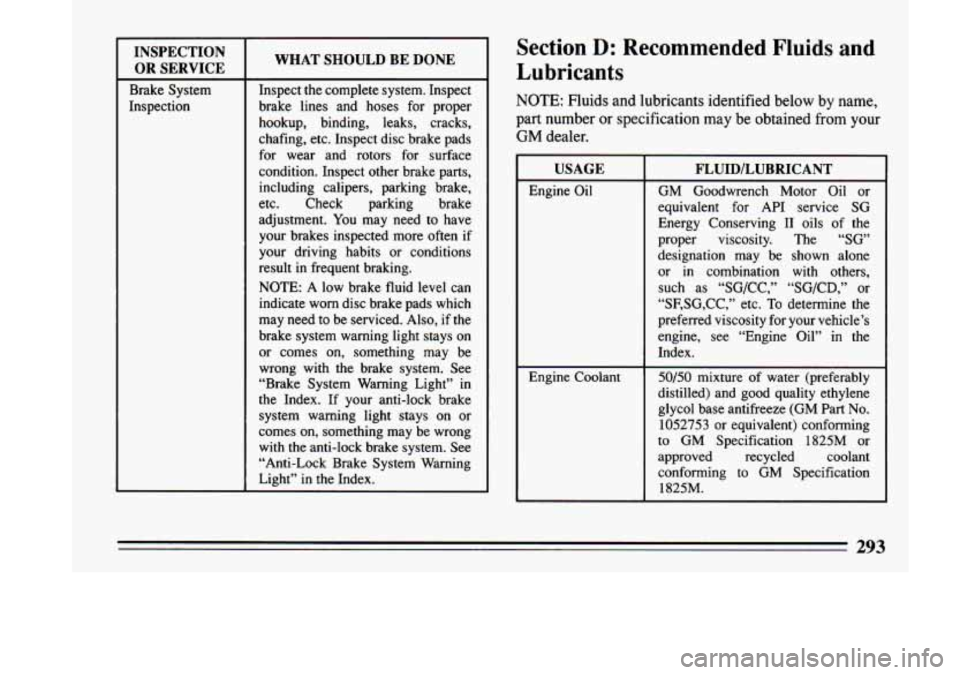
INSPECTION OR SERVICE
Brake System
Inspection
WHAT SHOULD BE DONE
Inspect the complete system. Inspect
brake lines and hoses for proper hookup, binding, leaks, cracks,
chafing, etc. Inspect disc brake pads
for wear and rotors for surface
condition. Inspect other brake parts, including calipers, parking brake,
etc. Check parking brake
adjustment.
You may need to have
your brakes inspected more often
if
your driving habits or conditions
result in frequent braking.
NOTE:
A low brake fluid level can
indicate worn disc brake pads which
may need to be serviced. Also,
if the
brake system warning light stays on
or comes on, something may be
wrong with the brake system. See
“Brake System Warning Light” in
the Index. If your anti-lock brake
system warning light stays
on or
comes on, something may be wrong
with the anti-lock brake system. See
“Anti-Lock Brake System Warning
Light” in the Index.
Section D: Recommended Fluids and
Lubricants
NOTE: Fluids and lubricants identified below by name,
part number
or specification may be obtained from your
GM dealer.
FLUID/LUBRICANT
GM Goodwrench Motor Oil or
equivalent for API service SG
Energy Conserving I1 oils of the
proper viscosity. The
“SG’
designation may be shown alone
or
in combination with others,
such as “SG/CC,” “SG/CD,” or
“SF,SG,CC,” etc.
To determine the
preferred viscosity for your vehicle’s
engine, see “Engine Oil’’ in the
Index.
50/50 mixture of water (preferably
distilled) and good quality ethylene
glycol base antifreeze (GM Part
No.
1052753 or equivalent) conforming
to GM Specification 1825M or
approved recycled coolant
conforming to GM Specification
1825M.
293
-